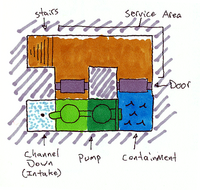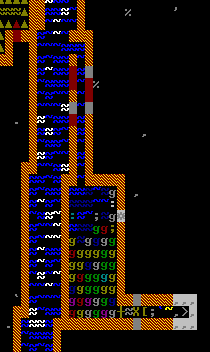- v50 information can now be added to pages in the main namespace. v0.47 information can still be found in the DF2014 namespace. See here for more details on the new versioning policy.
- Use this page to report any issues related to the migration.
Drowning chamber
| Part of a number of articles on |
| Projects |
|---|
| Basic |
| Aqueduct • Archery tower • Atom smasher • Danger room • Dam • Garbage dump • Mass pit • Moat • Pit trap • Reservoir• Sally port • Swimming pool • Tower • Tree farm |
| Advanced |
| Drowning chamber • Magma piston • Obsidian farm • Pump stack • Silk farm • Water reactor |
v50.12 · v0.47.05 This article is about the current version of DF.Note that some content may still need to be updated. |
Drowning chambers are multipurpose rooms (basically advanced pit traps) that can rapidly fill up with and be drained of water. An effectively built drowning chamber linked up to a dammed river or open to the ocean can be used to drown and dispose of invaders, hippies, loudmouths, rich tourists and other above-ground nuisances, as long as they have a need to breathe and cannot breathe underwater. It is thus an effective defensive strategy, acting like a megaproject trap that can dispose of almost anything that threatens you from the surface. A more powerful and noticeably more dwarven variation of a drowning chamber (using magma of course) is a melting chamber, which is truly 100% effective against surface-based threats.
Smaller-scale drowning chambers can be turned into large fishing traps as part of your fishing industry, to capture large fish for butchering that cannot be otherwise easily caught. This is done by filtering a water source through a room lined with cage traps; fish will inevitably go in to explore and be caught in them, allowing you to drain the room and then mark the trapped animal for butchering. If you manage to capture a sperm whale or two, this will be enormously, enormously profitable.
Note that military drowning chambers can be relatively easily converted into fish-catching chambers when needed, but the reverse is not necessarily true.
Construction[edit]
Water flow[edit]
The first prerequisite of a drowning chamber is a large source of water that can be easily rerouted, be it a river, a natural body of water, or a constructed reservoir. This can be achieved in a few ways.
- Floodgates leading into an ocean or lake, if one is on the map; simply dig a channel through to one tile away from the body of water, put a floodgate there, link it to a lever, pull the lever, dig a hole, and then pull the lever again to plug the hole for when it's needed. Repeat for increasing amounts of flow.
- If you have a river on the map, you can dam the river to redirect its flow into your chamber. The difficultly of this is trivial if your river freezes over in the winter, but generally quite challenging otherwise, requiring either magma tricks or a lot of idle hands and a large collapsible chamber underneath; see dam for more information on that.
- You can always build a series of one-tile floodgates into the river wall as well, although this tends to have decreased flow.
- Enough small lakes (quite common) can be drained to form a cistern that can be cycled in and out of the chamber as a closed system.
- A pump stack can bring water from a cavern lake up to the surface for use, although this would require a cistern to be effective.
- An even larger pump stack can bring magma up to the surface, and allow you to convert your drowning chambers into melting chambers. After all, who needs water when you can turn your enemies into carbon fumes? *Simply* build a magma reservoir, link it to your chamber, and marvel at how quickly it disposes of anything foolish enough to enter. Note that if you build a magma death chamber you will need to do so with magma-safe materials unless you are heading straight for Fun.
- With a volcano, melting chambers are trivial to construct - just use your natural lava source.
- If you have an aquifer on the map, you can use a screw pump to bring the water up from even closer to the surface than a cavern lake; simply dig into the aquifer and use the water-producing tile as your pump input.
Trapping[edit]
Once you have worked out your water supply, you need to work out the room. A military drowning chamber can be a simple sally port (a secondary hallway leading into your fortress with bridges on both sides). Upon seeing the enemy, close down your main entrance while leaving the secondary open. Enemies will path to your fortress using the shortest route possible and walk in, at which point you can close the bridges, trapping them inside for the ensuing flood. Building destroyers like titans and werebeasts are unable to destroy the walls created by erect bridges, so this design works against most everything, even otherwise unassailable megabeasts.
Note that ambushes sneak onto the map and must be spotted first. Leaving an entrance wide open to them into the heart of your fortress unwatched can spell your doom. Keep a sacrificial animal or watchtower or something near the entrance, to keep eyes on enemy ambushes.
A fishing drowning chamber is much easier; simply cover the room in cage traps and open it up to your water flow. Once you have trapped some fish, drain the room and let your dwarves come in and haul them away for butchering. Note that a military death chamber can easily be adapted into a fishing chamber, but the reverse is not necessarily true.
Drainage[edit]
The final piece of a drowning chamber is its pumping mechanisms. You want to be able to empty out a drowning chamber for reuse and for claiming what the unfortunate victims were carrying. What's the point of a trap that only works once?
- The simplest approach is to use an exploit called a portable drain--a minecart that dumps the water into non-existence.
- One way to pump off excess water is a battery of wind-powered screw pumps. Simply build a windmill one tile above your pump to power it. Since it's going to be off most of the time (or not, if it's for catching fish), build a floor hatch over the input tile and attach it to a lever for easy on/off commands. If you don't have any wind on your map, a water wheel can be substituted instead, but if there is no running water on your map, this can be quite complicated.
- If you can spare a lot of mining labor, you can always opt to build a room big enough for the water to evaporate out of. This will require a room several times larger than the drowning chamber itself, and will not get rid of the water as quickly, but requires much less fiddling to get right.
- If you have a strong computer and wouldn't mind an FPS drop, you can simply dump the water down several levels into the nearest cavern and flow it off the map edge. A simple hole will suffice, but a more advanced "guided" system (ae. walls) will work faster, although it will require dangerous cavern work first.
Where the screw pumps drain off to is your decision. If you are using a cistern, run the water back into your water supply. You can dig a tunnel through to the map edge and funnel it out of your game. You can build a small waterfall and drop it back into the water source it had come from in the first place, although this will probably require more screw pumps, as they do not create any pressure.
When draining the pit, items and corpses will be pushed through fortifications or wall grates by moving water. This could get them stuck into an inaccessible location on the wrong side of the filters. Instead of draining the water on the same Z-level as the drowning chamber, drain the water downward through floor grates or stairs to a lower Z-level, because items cannot be pushed downward through floor grates or stairs by moving water.
When used for fishing, the object is to filter water through, not fill and drain it all at once, although you will want to be able to drain it completely as well too, to carry the fishies out.
Order of construction[edit]
- Dig out the drowning chamber itself. It is recommended you make it three tiles wide, so that you can "test" it on human caravans if you feel like it. It should be at least 15 units in length, and probably more, to allow leeway in lever pulling.
- Construct the entrance and exit bridges, and link them to levers to keep nasties out while the chamber is still under construction. You can also convert it into a pit trap in this way, but only if you really really have to.
- Dig out and fit your water source. You may have done this already, and this may be the most difficult step.
- Dig out the pump housing. Channel off in three-square spaces (less means slower draining, more means faster) and then build an upwards ramp to behind the wall of the chamber. Dig a two-tile space for the actual screw pump, and then link the screw pump outputs together so the water can be syphoned away to your water dump, whatever that happens to be.
- Remove the upwards ramps you dug out from the far side of the pump housing, as this will prevent you from building the necessary floor hatches.
- Place some floor hatches over the new hole you created. This will be your screw pump input and control; link the hatches to levers so you can turn drainage on/off when needed. A floodgate below will also work.
- Place some floor bars over the input ramp. Unlike hatches, floor bars are unaffected by ramps.
- Build your power sources. The easiest way to do this is to place a windmill directly over where the screw pump will be — the power will magically siphon through the ground with no problem, but only if the windmill is built first.
- If your screw pumps are located more than one tile beneath your windmills (or water wheels), you will have to dig out and channel down to them from the z-level above in order to fit a mechanism there, and will have to reverse the order of the previous and next step - mechanisms must be hung from screw pumps, and windmills in turn must be hung from the mechanisms.
- Finally, build the screw pumps. Lock off the entrance to the pressure tunnel with a levered floodgate, so you can access it later if needed.
Each screw pump assembly requires one screw pump, one floor hatch, one set of floor bar, and one windmill; in terms of raw materials this is one block, one enormous corkscrew, one grate, one hatch, one pipe section, and four logs per unit of drainage.

|
This article or section has been rated D for Dwarf. It may include witty humour, not-so-witty humour, bad humour, in-jokes, pop culture references, and references to the Bay12 forums. Don't believe everything you read, and if you miss some of the references, don't worry. It was inevitable. |
Or you were looking for trade depot or swimming pool instead?
"Drowning chamber" in other Languages
|

